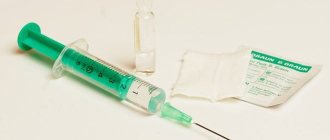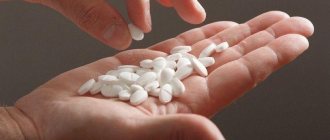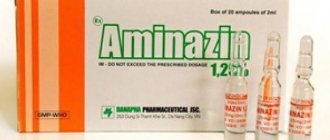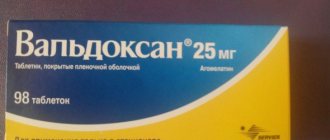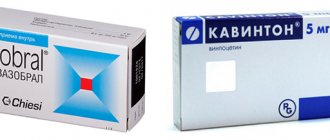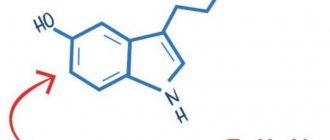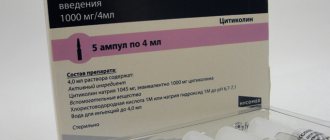Analogues of the drug according to ATC codes:
OPRAH PRAM SIOSAM CYTALORINE CYTOL
Before using CIPRAMIL you should consult your doctor. These instructions for use are for informational purposes only. For more complete information, please refer to the manufacturer's instructions.
Cost and analogues
The price of a package of the drug Tsipramil is from 1768 to 1953 rubles per package. The cost may vary depending on the pharmacy and the form of the drug.
Analogues of Tsipramil:
- Auropram;
- Oropram;
- Pram;
- Cytahexal;
- Citalostad;
- Tsitalam;
- Cytol;
- Cytoles;
- Precipra.
A popular analogue of the drug is Cipralex, however, it represents a different subgroup of antidepressants and is based on a different active ingredient. The decision about which is better: Cipralex or Cipramil should be made by the attending physician.
Release form, composition and packaging
White film-coated tablets, oval, scored, marked “C” and “N” symmetrically near the score.
| 1 tab. | |
| citalopram hydrobromide | 24.98 mg, |
| which corresponds to the content of citalopram | 20 mg |
Excipients: corn starch, lactose monohydrate, copovidone, glycerol 85%, microcrystalline cellulose, croscarmellose sodium, magnesium stearate.
Shell composition: hypromellose 5, macrogol 400, titanium dioxide (E171).
14 pcs. - blisters (1) - cardboard packs. 14 pcs. - blisters (2) - cardboard packs.
White film-coated tablets, oval, scored, marked “C” and “N” symmetrically near the score.
| 1 tab. | |
| citalopram hydrobromide | 49.96 mg, |
| which corresponds to the content of citalopram | 40 mg |
Excipients: corn starch, lactose monohydrate, copovidone, glycerol 85%, microcrystalline cellulose, croscarmellose sodium, magnesium stearate.
Shell composition: hypromellose 5, macrogol 400, titanium dioxide (E171).
14 pcs. - blisters (2) - cardboard packs.
Contraindications to medication use
For what conditions should you not use Citalopram?
Reviews indicate the following contraindications to the use of this medicine:
- the patient’s minor age (according to the instructions, the safety and effectiveness of using such tablets at this age have not been established);
- high sensitivity of the patient to citalopram, as well as to any of its excipients;
- when taken simultaneously with monoamine oxidase inhibitors, including moclobemide, selegiline, linezolid (within two weeks after stopping their use);
- while taking medications that prolong the QT period on the ECG (including pimozide), as well as with congenital prolongation of this interval).
pharmachologic effect
Antidepressant, selective serotonin reuptake inhibitor. The antidepressant effect usually develops after 2-4 weeks of therapy. Tsipramil has virtually no or insignificant ability to bind to a number of receptors, including histamine, m-cholinergic receptors and adrenergic receptors. There is no sedative effect.
It inhibits cytochrome P450 IID6 to a very small extent, and therefore does not interact with drugs metabolized by this isoenzyme.
Tsipramil has no effect on the conduction system of the heart and blood pressure, does not change hematological parameters, liver and kidney functions; does not cause weight gain.
"Pram": Tips and reviews
Lyudmila. An excellent remedy for getting rid of problems with the nervous system. Taking Prama did not cause any side effects for me. My alcoholic ex-husband put me under constant stress. It even got to the point where she wanted to commit suicide. I have been taking it for over 3 years. True, lately it has become very difficult to find him.
Zoya. If I feel like my nerves are getting crazy, I start taking Pram. It acts gently, improves mood and, most importantly, does not cause drowsiness. Unlike analogues, it does not cause insomnia. Which is very important to me. I fought for a long time for my healthy sleep.
Pharmacokinetics
Suction
After oral administration, Cmax of citalopram in plasma is achieved within 2-4 hours.
Bioavailability when taken orally is about 80%.
Distribution
Changes in plasma concentrations of citalopram are linear. Css in plasma is established after 1-2 weeks of therapy.
Plasma protein binding is less than 80%.
Metabolism
In blood plasma, citalopram is present mainly unchanged. Metabolized by demethylation, deamination and oxidation.
Removal
T1/2 is 1.5 days. Excreted by the kidneys and through the intestines.
Lundbeck antidepressant Cipralex (escitalopram)
Hello!
I really hope that my review will be useful. When I had problems, I no longer believed in anything...
It all started with the fact that my osteochondrosis became inflamed, as usual. I have problems with the thoracic and cervical spine. As always, I endured, I thought that it would pass, but it didn’t work out that way... Along with these problems, there were also “nightmares” in my head... What I experienced, only God knows... Where have I been, how much money was spent on treatment….It’s a nightmare, it’s hard to remember.
I felt a terrible burning sensation and great discomfort in my head and sometimes throughout my body. The unpleasant sensations in my head were very strong.
I was treated in hospital 2 times. My previously diagnosed diagnosis was confirmed - signs of straightened lordosis, osteochondropathy of the CERVICAL spine + osteochondrosis of the thoracic spine. And because of this (neck problems), all the “troubles” happen to the head...
I went through a course of IV drips, I was injected with a bunch of drugs, I took more than one course of different pills... Nothing helped me... What did I not think then. I suffered for a very long time, several months. Before prescribing me Cipralex, my neurologist prescribed me much weaker drugs. But my condition worsened, tears, hysterics, panic attacks began... I had constant anxiety, depression, and a terrible moral state. I lost a lot of weight. This scared me terribly. I lost interest in everything: my favorite activity was no longer interested, the child was “on his own” (even though this is the most precious thing to me), and I often quarreled with my husband. I was almost constantly lying in bed.
~~~~~~~~~~~~~~~~~~~~~~~~~~~~~~~~~~~~~~~~~~~~~~~~~~~~~~~~~~~~~~~~~~~~~~~~~~
What is depression?
Depression is not just a bad mood. This is a serious illness that includes a whole range of symptoms.
~~~~~~~~~~~~~~~~~~~~~~~~~~~~~~~~~~~~~~~~~~~~~~~~~~~~~~~~~~~~~~~~~~~~~~~~~~
Time passed, I was exhausted myself and exhausted everyone around me. There is probably no neurologist in our city that I haven’t contacted! And they all unanimously said that I had postpartum depression, which manifests itself in physical pain... And I argued that I did not have any depression (to be honest, there were no shocks or stress that could lead to this at all)! !! My depression has already begun, and I agree with this, but it started from a long time of painful sensations! It got to the point where I then turned to a psychiatrist for help.
What they didn’t advise me to do: get distracted (what kind of distraction are we talking about if Krisha is blown away from PAIN!!! Not from a moral state), go on vacation (what a vacation, I couldn’t think about food then), embroider (my favorite pastime) , go to work (this is completely nonsense, how could I WORK IN THIS CONDITION???), etc. and so on.
This drug helps me with headaches.
Therefore, the phrase “Pull yourself together!” so often uttered to such patients by their relatives is not only meaningless, but even blasphemous. A depressed patient cannot pull himself together, in any way!
Lost sleep and appetite.
If it weren’t for the people close to me, I could have gone crazy, but I’m not exaggerating!!!
When all hopes for recovery were gone, and once again I went to the doctor with an upset face, she prescribed me CIPRALEX. The price now is approximately 600 UAH, although then I bought it for 800 UAH. (there was a wave of price increases) I started taking them. I didn’t see a way out, although I was honestly “afraid” of such drugs, since I’m generally afraid of antidepressants... I don’t know if it’s a myth or not, but I heard that drugs for depression are addictive.
Among “normal” people there is an opinion that “antidepressants are very harmful”, “you can go crazy from them”, “you get used to them for life”, etc. Is this true? Of course, there is no smoke without fire, but fire is a cost of Soviet psychiatry, when potent drugs “just in case” were prescribed in large doses with corresponding results.
The doctor reassured me and said that this is a very good drug. I had to accept it.
The tablets are white, convex, coated with a score and marked “E” and “L”.
INDICATIONS FOR USE:
Depressive episodes of any severity. Panic disorders with or without agoraphobia. Social anxiety disorder (social phobia). Generalized anxiety disorder. Obsessive-compulsive disorder.
COMPOUND:
active substance – escitalopram oxalate. Excipients: talc, croscarmellose sodium, microcrystalline cellulose, colloidal anhydrous silicon, magnesium stearate. Shell – hypromellose, macrogol 400, titanium dioxide (E 171)
HOW I took it:
~~~~~~~~~~~~~~~~~~~~~~~~~~~~~~~~~~~~~~~~~~~~~~~~~~~~~~~~~~~~~~~~~~~~~~~~~~~~
I started with a very small dose. First, 1/4 tablet (as the doctor advised). Then, after about a week, I started increasing the dose. Then I took 1 tablet 1 time per day.
~~~~~~~~~~~~~~~~~~~~~~~~~~~~~~~~~~~~~~~~~~~~~~~~~~~~~~~~~~~~~~~~~~~~~~~~~~~~
Film-coated tablets in packs of 14 or 28 pieces.
During the first week of treatment, a dose of 5 mg/day is recommended, which is then increased to 10 mg/day. Depending on the patient’s individual response, the dose can be increased to a maximum of 20 mg/day.
Of course, there are many possible SIDE EFFECTS described in the instructions. It's worth checking out.
Mode of application:
Cipralex is prescribed orally once a day, regardless of food intake. Depressive episodes Usually prescribed 10 mg once a day. Depending on the patient’s individual response, the dose can be increased to a maximum of 20 mg/day.
~~~~~~~~~~~~~~~~~~~~~~~~~~~~~~~~~~~~~~~~~~~~~~~~~~~~~~~~~~~~~~~~~~~~~~~~
They are produced in dosages of 5 mg, 10 mg and 20 mg. Dispensed with a doctor's prescription.
On the very first day of admission, nausea and depression were added to all my “happiness”. It was like that for a long time. Few weeks. Nothing, just nothing changed for the better then...
After that, I was taken to the hospital again and after an examination, before all this, Miaser was added at night, half a dose. This is such a sad story.
~~~~~~~~~~~~~~~~~~~~~~~~~~~~~~~~~~~~~~~~~~~~~~~~~~~~~~~~~~~~~~~~~~~~~~~~~
The antidepressant effect usually develops 2-4 weeks after the start of treatment.
The maximum therapeutic effect is achieved approximately 3 months after the start of treatment. Therapy lasts several months.
But after some time, at least I felt better mentally. I pulled myself together, although it was very difficult for me to do so.
Manufacturer's name and address
H. Lundbeck AO Ottiliavai 9, DK-2500 Valby, Copenhagen, Denmark
I took a course of massages, manual therapy, and acupuncture. Well, here’s a review of this procedure.
I also had an MRI done, which I will also tell you about later.
I was treated for a very long time. The full course is about 8 months. I also came off this drug for a long time and gradually. DO NOT throw abruptly!!!
She gradually reduced the dose, and then stopped taking it altogether. I didn't notice the cancellation.
********************************************************************************************************************
More briefly:
Pros:
gets me out of depression (after all, I’m more inclined to think that it was he who helped me return to my old life) the pills are very easy to swallow. Its effect is profound, relieves fear and anxiety and is not addictive
********************************************************************************************************************
Minuses:
the fairly high price does not begin to take effect immediately (several days, or even weeks) drowsiness (but not very disturbing) will not completely relieve depressive experiences.
*********************************************************************************************************************
The second time (the next year), when the burning sensation in my head recurred again, anxiety and fear began to haunt me again, I took, so to speak, “easier” pills that helped me get rid of all the troubles. I was prescribed this drug.
I advise you to always consult a doctor; nothing good will come from self-medication!
OK it's all over Now!
Thank you for your attention. Do not be ill!
I hope my review will be useful to someone.
CIPRAMIL: DOSAGE
The drug is prescribed 1 time/day.
For depression, the drug is prescribed at a dose of 20 mg/day. Depending on the individual response of the patient and the severity of depression, the dose may be increased to a maximum of 60 mg/day.
For panic disorders, during the first week of treatment the recommended dose is 10 mg/day, then the dose is increased to 20 mg/day. Depending on the patient’s individual response to the drug, the daily dose may subsequently be increased. The maximum dose is 60 mg/day.
For obsessive-compulsive disorders, the initial dose of the drug is 20 mg/day. If necessary, the dose can be increased. The maximum dose is 60 mg/day.
In elderly patients, the recommended dose is 20 mg/day. Depending on the individual response and severity of depression, the dose may be increased to a maximum of 40 mg/day.
For patients with severe liver dysfunction, the drug is prescribed in the minimum recommended doses. Tsipramil can be taken regardless of meals, at any time of the day.
Scope of application and contraindications
Tsipramil is prescribed in the following cases:
- depressive states of various origins and structures;
- obsessive-compulsive disorder;
- panic attacks;
- stressful conditions;
- psychoemotional disorders with the presence or absence of agoraphobia;
- phobias of various origins.
The remedy is also used when the patient experiences an increased level of anxiety, a sense of fear, aggressiveness, nervousness, apathy, irritability, disturbed sleep, tearfulness, dissatisfaction with life and reluctance to live, suicidal behavior, and self-doubt.
Tsipramil has a relatively small list of contraindications for use.
These include:
- lactase deficiency as a result of a hereditary factor;
- QT interval prolongation syndrome;
- hypersensitivity to galactose;
- impaired absorption of galactose or lactase;
- age up to eighteen years;
- serotonin syndrome;
- frequent pressure surges (increase or decrease);
- high sensitivity to the active or auxiliary component of the drug;
- simultaneous use of MAO inhibitors.
Article on the topic: Ointment 911 - composition, indications and instructions for use
For diseases such as bradycardia, diabetes mellitus, arrhythmia, hypomagnesemia, myocardial infarction, hypokalemia, hepatic, renal and heart failure, the drug is used with caution. The medicine is also used under medical supervision to treat patients prone to bleeding.
In old age, dosage adjustment is necessary.
Overdose
Symptoms: drowsiness, coma, articulation disorders, occasionally - grand mal seizures, sinus tachycardia, sometimes junctional rhythm, increased sweating, nausea, vomiting, cyanosis, hyperventilation. The clinical picture is not typical.
Treatment: it is necessary to rinse the stomach as soon as possible after taking the drug. Conduct symptomatic and supportive therapy. Monitoring the patient's condition is recommended. There is no specific antidote.
Pharmacodynamics and pharmacokinetics
Pharmacodynamics
Selective serotonin reuptake blocker, antidepressant .
The antidepressant effect usually develops after 3-4 weeks of treatment. The drug Tsipramil has almost no ability to bind to many receptors, including m-cholinergic receptors, histamine and adrenergic receptors . Does not have a sedative effect.
Slightly inhibits cytochrome P450 IID6 , as a result of which it does not interact with drugs metabolized by this isoenzyme.
Tsipramil does not affect the rhythm conduction system, blood pressure, hematological parameters and the functioning of the kidneys and liver; does not cause weight gain.
Pharmacokinetics
The maximum plasma content is recorded on average 4 hours after oral administration. Bioavailability in this case is about 80%.
Equilibrium concentration is established after 1-2 weeks of treatment. Reaction with blood is less than 80%.
Metabolized through deamination, demethylation and oxidation . The half-life reaches 36 hours. The active substance is excreted in the urine and through the intestines.
Drug interactions
With the simultaneous use of Tsipramil and MAO inhibitors, the development of a hypertensive crisis (serotonin syndrome) is possible.
When used together, cimetidine causes a moderate increase in the average steady-state concentration of citalopram in the blood (therefore, Cipramil should be prescribed with caution in maximum doses while taking cimetidine in high doses).
No clinically significant pharmacokinetic interaction of Tsipramil with phenothiazines and tricyclic antidepressants has been identified.
Clinical studies have not revealed pharmacodynamic interactions between Tsipramil and concomitantly used benzodiazepines, antipsychotics, analgesics, lithium preparations, antihypertensive drugs, antihistamines, beta-blockers and other cardiotropic drugs.
There was no interaction between Tsipramil and ethanol.
The effects of sumatriptan and other serotonergic drugs may be enhanced by citalopram.
Side effects
When using Tsipramil, side effects and reactions from the following organs and their systems are possible:
- respiratory – nosebleeds, yawning;
- digestive – constipation, vomiting, diarrhea, organ bleeding, hepatitis;
- cardiovascular - tachycardia, hypotension, bradycardia;
- nervous – paresthesia, dizziness, serotonin syndrome, sleep disorders, convulsions, fainting;
- skin and subcutaneous tissue - increased sweating, rashes and itching on the skin, angioedema, purpura;
- genitourinary – ischuria, profuse menstruation, uterine bleeding.
In addition, problems with the reproductive system may occur. Myalgia, joint pain, ringing in the ears, blurred vision, thrombocytopenia, decreased appetite, weight loss, hypokalemia, hallucinations, and sleep disturbances often appear.
CIPRAMIL: SIDE EFFECTS
From the digestive system: dry mouth, nausea, diarrhea.
From the side of the central nervous system: drowsiness, tremor, weakness, agitation, insomnia; in exceptional cases - convulsive seizures (when using the drug in high doses).
From the cardiovascular system: a slight decrease in heart rate is possible, which usually has no clinical significance. However, in patients with an initially low heart rate, the drug may cause bradycardia.
Other: increased sweating, sexual dysfunction. Hyponatremia, manifestations of serotonin syndrome, withdrawal syndrome, extrapyramidal disorders, and purpura can occur extremely rarely.
Side effects are usually transient and mild. They are observed mainly during the first 2 weeks of treatment and usually decrease significantly as the patient's condition improves.
Cipramil (Citalopram)
Sexual dysfunction is a common side effect of SSRIs. Specifically, common side effects include difficulty becoming aroused, lack of interest in sex, and anorgasmia (trouble achieving orgasm). Genital anesthesia, loss or decreased response to sexual stimuli, and ejaculatory anhedonia are also possible. Although these sexual side effects are usually reversible, in some people they may become permanent after stopping the drug completely. This effect is called "post-SSRI sexual dysfunction." Citalopram may theoretically cause side effects by increasing serotonin concentrations in other parts of the body (such as the intestines). Other side effects of Cipramil, such as apathy and emotional flattening, may be caused by decreased dopamine release, which is associated with increased serotonin levels. Citalopram is also a mild antihistamine, which may interfere with some of its sedative properties. Common side effects of Citalopram include drowsiness, insomnia, nausea, weight changes, vivid dreams, frequent urination, decreased sex drive, anorgasmia, dry mouth, increased sweating, shaking, diarrhea, excessive yawning and fatigue. Less common side effects include bruxism, vomiting, abnormal heart rhythms, blood pressure, dilated pupils, anxiety, mood swings, headaches and dizziness. Rare side effects include convulsions, hallucinations, and severe allergic reactions. During sedation, the drug can be taken before bedtime, rather than in the morning. Cipramil and other SSRIs may cause mixed symptoms, especially in patients with undiagnosed bipolar disorder. Citalopram should not be taken with St. John's wort, tryptophan, or 5-HTP as these drug interactions may lead to the development of serotonin syndrome. St. John's wort contains compounds that reduce the effectiveness of liver cytochrome P450 enzymes. Additionally, some scientists have suggested that such compounds, including hypericin, hyperforin, and flavonoids, may have SSRI-like effects on the nervous system, although these claims are still subject to debate. In one study, St. John's wort extract was shown to act similarly to Citalopram, with fewer side effects, in the treatment of moderate depression. Tryptophan and 5-HTP are precursors to serotonin and can cause an increase in serotonin levels. Concomitant use of Cipramil with SSRIs such as Citalopram can lead to a dangerous increase in serotonin levels. This phenomenon may also occur when SSRIs are co-administered with serotonin releasing agents (SRAs), such as MDMA. It is likely that SSRIs may reduce the effects associated with SRA due to the fact that SSRIs stop serotonin reuptake by blocking SERT. This allows less serotonin to move in and out of transporters, thus reducing the likelihood of neurotoxic effects. However, these effects are still controversial as the pharmacodynamic interaction of Citalopram and MDMA has not yet been fully determined. In the US, federal health regulators are warning doctors about the risk of prescribing Cypramine in high doses due to the potential for serious heart complications. The FDA has stated that in doses above 40 mg, the drug can affect the electrical activity of the heart and even cause sudden death. In addition, a dose of 20 mg per day is the maximum dose recommended by the FDA for patients with hepatic impairment over the age of 60 years who are poor CYP2C19 metabolizers, or for patients concomitantly taking cimetidine (brand name Tagamet), as these factors lead to increased levels of Citalopram in the blood, increasing the risk of prolongation of the QT interval and the development of polymorphic ventricular tachycardia. SSRIs, including Cipramil, may increase the risk of bleeding, especially when combined with aspirin, NSAIDs (nonsteroidal anti-inflammatory drugs), warfarin, or other anticoagulants. Cipramil is contraindicated for people taking MAO inhibitors due to the possible development of serotonin syndrome. When taken together with Prilosec, the elimination of Citalopram from the body may be reduced, which may lead to increased levels of Citalopram in the blood. Prilosec inhibits the CYP450 2C19 enzyme, one of the two main enzymes responsible for the metabolism of Citalopram. Dosage adjustments may be necessary to combat this effect. SSRI withdrawal syndrome occurs when treatment is stopped. To reduce the occurrence and severity of withdrawal symptoms, gradual discontinuation of Citalopram is recommended. Some doctors, when stopping treatment with Citalopram, prefer to switch the patient to Prozac (Fluoxetine), since Prozac has a much longer half-life (i.e., remains in the body longer compared to Citalopram). This may help avoid many of the severe withdrawal symptoms associated with stopping Citalopram. The patient can either use a single 20 mg dose of Prozac or start at a low dose of Prozac and taper off. Any of these drugs can be used in liquid form to slowly and gradually reduce the dosage. In addition, patients wishing to stop taking Citalopram should visit a compounding pharmacy where their prescriptions should be refilled to a reduced dosage. According to the FDA, Cipramil "may cause abnormal changes in the electrical activity of the heart" and fatal changes in heart rhythm. The higher the dose, the greater the risk to the heart.
special instructions
Cipramil, like other selective serotonin reuptake inhibitors, should not be prescribed while using MAO inhibitors, or within 14 days after stopping their use. Treatment with MAO inhibitors can be started 7 days after stopping Cipramil.
For moderate renal impairment, no dosage adjustment is required.
If the depression phase is inverted and a manic state develops, Cipramil should be discontinued.
Impact on the ability to drive vehicles and operate machinery
Tsipramil does not reduce the ability to think and the speed of psychomotor reactions. However, it should be borne in mind that patients with depression often experience a decrease in the ability to concentrate, which can be aggravated by the use of psychotropic drugs. Taking this into account, when prescribing Tsipramil for depression, the patient should be warned about a possible decrease in the ability to concentrate and the speed of psychomotor reactions when driving a car and working with machinery.
Can antidepressants cause addiction, and what are the side effects of citalopram?
Like all medicines, citalopram may cause side effects in some people, but many people have no or only minor side effects.
Some of the common side effects of citalopram will gradually improve as your body gets used to taking the antidepressant citalopram. Side effects like fatigue, dry mouth and sweat are common. They are usually standard and go away within a couple of weeks.
Some people who take citalopram for panic attacks find that their anxiety gets worse during the first few weeks of treatment.
This usually goes away after a few weeks, but talk to your doctor if it bothers you - a lower dose may help reduce your symptoms.
In adults and teenagers, some common side effects after taking citalopram include: dizziness, headache, insomnia, gastrointestinal upset, increased appetite, urinary retention.
Similar drugs:
- Miaser Oral tablets
- Life 900 (LIFE 900) Oral tablets
- Heptral Lyophilisate for the preparation of a solution for intramuscular, subconjunctival administration and for instillation into the eye
- Lenuksin Oral tablets
- Heptor (Heptor) Lyophilisate for the preparation of solution for injection
- Prodep Capsule
- Citalopram Oral tablets
- Paroxetine Oral tablets
- Spitomin Tablets
- Deprim forte Capsule
** The Drug Directory is intended for informational purposes only. For more complete information, please refer to the manufacturer's instructions. Do not self-medicate; Before starting to use the drug Cipramil, you should consult a doctor. EUROLAB is not responsible for the consequences caused by the use of information posted on the portal. Any information on the site does not replace medical advice and cannot serve as a guarantee of the positive effect of the drug.
Are you interested in the drug Cipramil? Do you want to know more detailed information or do you need a doctor's examination? Or do you need an inspection? You can make an appointment with a doctor - the Euro lab is always at your service! The best doctors will examine you, advise you, provide the necessary assistance and make a diagnosis. You can also call a doctor at home . Euro lab clinic is open for you around the clock.
** Attention! The information presented in this medication guide is intended for medical professionals and should not be used as a basis for self-medication. The description of the drug Tsipramil is provided for informational purposes and is not intended for prescribing treatment without the participation of a doctor. Patients need to consult a specialist!
If you are interested in any other drugs and medications, their descriptions and instructions for use, information about the composition and form of release, indications for use and side effects, methods of use, prices and reviews of drugs, or you have any other questions and suggestions - write to us, we will definitely try to help you.


